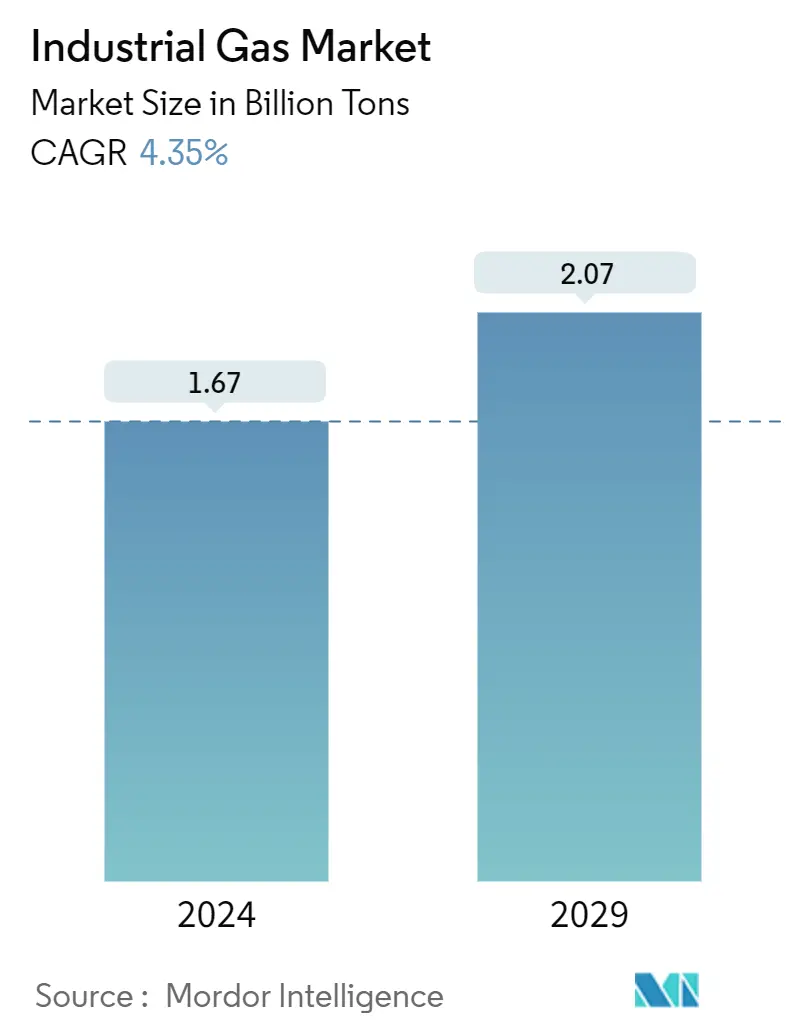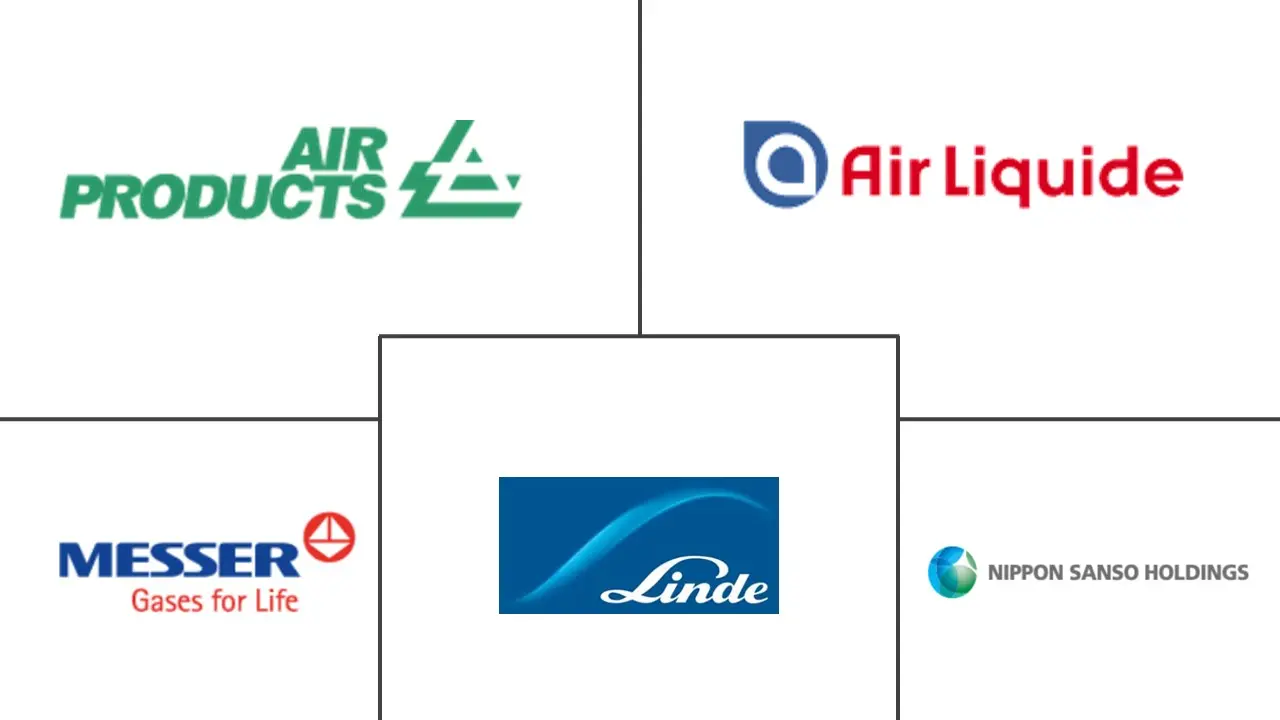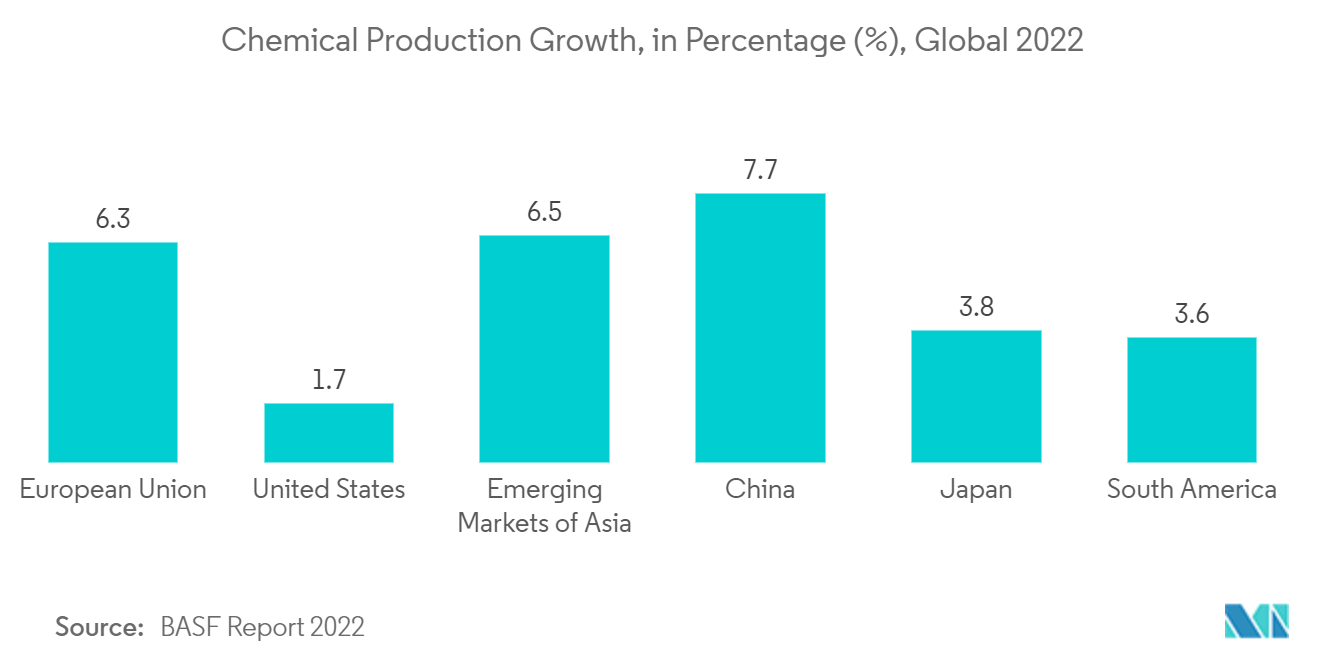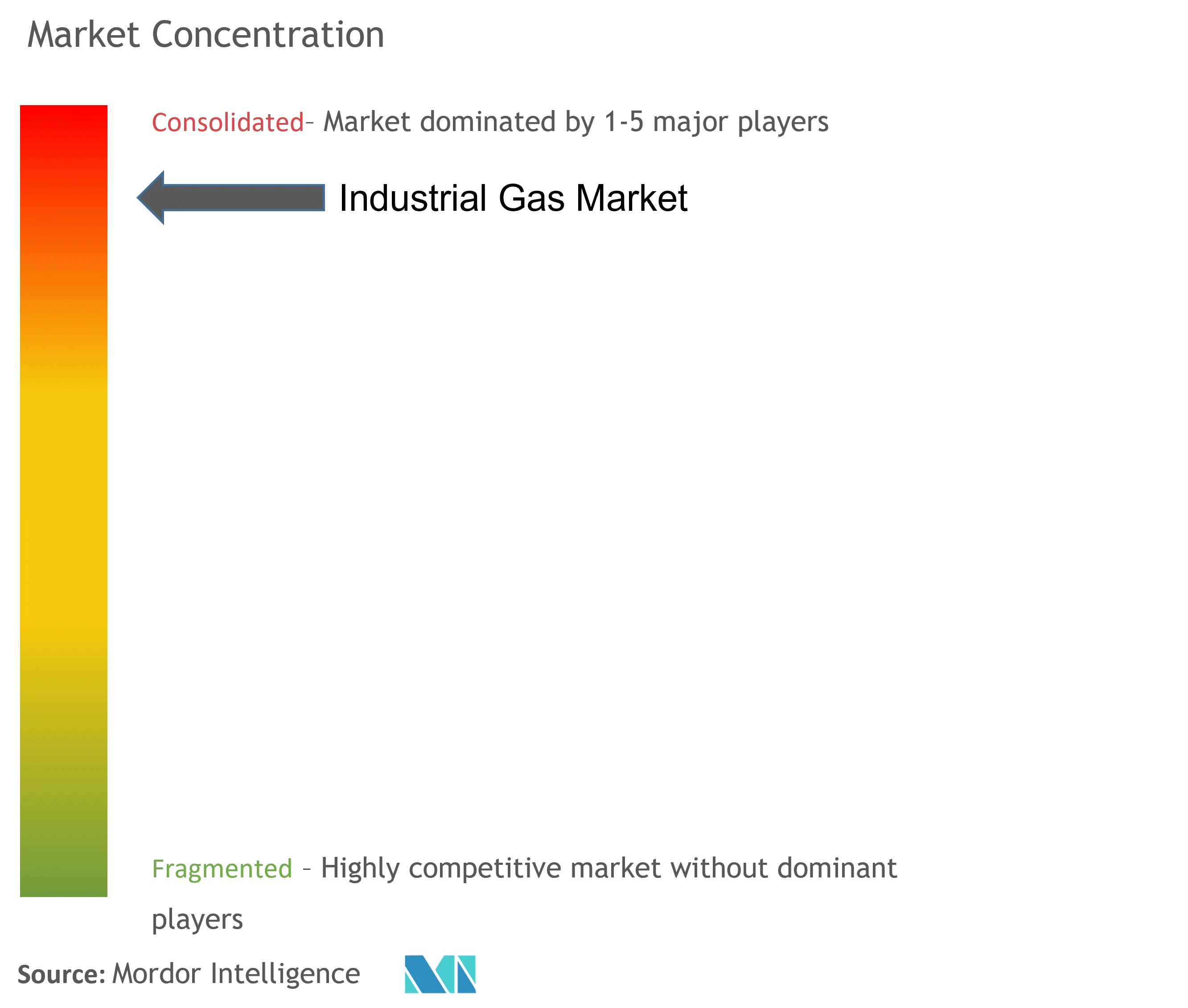Industrial Gases Market Size

| Study Period | 2019-2029 |
| Base Year For Estimation | 2023 |
| CAGR (2024 - 2029) | 4.35 % |
| Fastest Growing Market | Asia Pacific |
| Largest Market | Asia Pacific |
| Market Concentration | High |
Major Players
*Disclaimer: Major Players sorted in no particular order |
Industrial Gases Market Analysis
The Industrial Gas Market size is estimated at 1.67 Billion tons in 2024, and is expected to reach 2.07 Billion tons by 2029, growing at a CAGR of 4.35% during the forecast period (2024-2029).
COVID-19 negatively impacted the market in 2020. Carbon dioxide is used to produce carbonated soft drinks and soda water, which was affected owing to the pandemic scenario. However, the medical industry's demand for oxygen for resuscitation and inhalation therapy increased during the pandemic, stimulating the market's growth.
- Over the short term, the growing need for alternate energy sources and increasing demand from the healthcare sector are expected to drive the growth of the industrial gas market.
- Environmental regulations and safety issues are projected for the market's growth.
- Industrial growth in Asia-Pacific and Africa will likely create market opportunities in the coming years.
- The Asia-Pacific region is expected to dominate the market and will likely witness the highest CAGR during the forecast period.
Industrial Gases Market Trends
Increasing Demand from the Medical and Pharmaceutical Sector
- Industrial gases, such as oxygen, nitrogen, carbon dioxide, hydrogen, methane, and propane, are essential molecules required as reaction agents for various process steps in the chemical production chain.
- Industrial gases provide solutions for inerting, reactor cooling, and pH control. Petrochemicals are substances obtained from the refining and processing of petroleum and natural gases. They require inert atmospheres for transportation and storage, which is provided by nitrogen.
- In refineries, oxygen is used to enrich the air feed to catalytic cracking regenerators, increasing the units’ capacity. It is used in sulfur recovery units to achieve similar benefits. Oxygen is also used to regenerate catalysts.
- Large quantities of carbon dioxide are used as a raw material in the chemical process industry, especially for methanol and urea production.
- Hydrogen is mostly used in oil refining and chemical manufacturing. Hydrogen is used as a feedstock in the production of two industrial chemicals, ammonia and methanol. In refineries, it is used in various hydro-desulfurization (HDS) and hydrocracking procedures.
- Methane is used as a raw material in the chemical industry to make methanol, synthetic ammonia, acetylene, and methylene chloride, among others. Further, propane is used in the production of ethylene and propylene.
- The chemical industry across the world is projected to witness growth, owing to the increasing consumption, increasing export demand, and enabling government initiatives.
- Asia-Pacific has grown to be the hub for chemical processing globally. The chemical industry in countries such as China, India, and Japan has been growing rapidly. The largest proportion of the global chemicals market is held by Asia by far. Since 2012, it has continuously accounted for more than half of the global chemicals market.
- Chemical production in Asia overall increased by 4.2% in 2022. However, this varies greatly from country to country. India saw a significant increase in production (+4.6%). In contrast, production in Japan, South Korea, and Taiwan fell by 3.0%, 7.4%, and 12.9%, respectively.
- In the European Union (EU), chemical production fell sharply by 5.8% due to a sharp rise in natural gas prices. In Germany, this fell by around 12% as the production of gas-intensive basic chemicals ceased. The United Kingdom also experienced a significant decline in chemical production.
- In contrast, US chemical production increased by 2.3% in 2022. However, the underlying impact of weather-related production losses in 2021 played a major role. Meanwhile, production in South America grew at 2.6% in 2022, slightly slower than the previous year (+3.6%).
- Thus, the abovementioned factors are expected to influence the demand for industrial gases used in the chemical industry.

Asia-Pacific to Dominate the Industrial Gas Market
- Asia-Pacific is the largest market for industrial gases. China accounted for a major chunk of the consumption in the region. However, India is expected to witness the fastest growth in the region.
- China's aerospace industry is projected to return to profitability in 2022 after facing a significant decline in the previous years. The Civil Aviation Administration of China (CAAC) estimated the aviation sector to recover domestic traffic to around 85% of pre-pandemic levels.
- Industrial gases also find their application in transportation, including tire manufacturing using pressurized nitrogen, high-pressure argon for airbags, and carbon dioxide and nitrogen for precise and secure welding. According to the IATA (International Air Transport Association) report, India is poised to become the third-largest aviation market in the world by the end of 2030.
- As per the forecast given by the Ministry of Housing and Urban-Rural Development, China's construction sector is expected to maintain a 6% share of the country's GDP going into 2025. Considering the given forecasts, the Chinese government unveiled a five-year plan in January 2022 to make the construction sector more sustainable and quality-driven.
- In March of 2023, Air Liquide, a major industrial gas player, announced investing around EUR 60 million (~USD 65.64 million) to revamp two Air Separation Units (ASUs), which the Group operates in the Tianjin industrial basin in China. This announcement comes within the context of the renewal of a long-term industrial gases supply contract with Tianjin Bohua YongliChemical Industry Co., Ltd ('YLC'), a subsidiary of the BohuaGroup.
- India is the Asia-Pacific's second-largest iron and steel producer, and production is increasing rapidly yearly.
- Steel production in India reached a historic level of around 120 million tons per annum, making it the world's second-largest steel producer, as per the Indian government report in December 2022. The country accounts for around 4.8% of global steel production annually.
- The crude steel production in India rose by around 5.80% to 124.4 million tons (MT) in 2022, compared to 118.2 MT in 2021, according to World Steel Association data. India produced around 10.9 MT of steel between January-February 2023, down by around 0.2% compared to the same period in 2022, as per the World Steel Association data.
- Growing demand for iron and steel from various industries and the upcoming steel ventures, coupled with government initiatives to boost the manufacturing sector, is expected to boost the usage of mechanical gas creation units to address the mass prerequisites for modern gases.
- Therefore, the abovementioned factors are expected to drive market growth in th region in the coming years.

Industrial Gases Industry Overview
The industrial gas market is consolidated in nature. Some of the market's major players (not in any particular order) include Air Liquide, Messer Group GmbH, Nippon Sanso Holdings Corporation, Linde PLC, and Air Products Inc.
Industrial Gases Market Leaders
-
Air Liquide
-
Messer Group GmbH
-
Air Products Inc.
-
Linde PLC
-
Nippon Sanso Holdings Corporation
*Disclaimer: Major Players sorted in no particular order

Industrial Gases Market News
- April 2023: Nippon Gases Operations, a division of Nippon Gases Italia, announced the signing of an agreement with Enel Green Power Italia to construct a new plant for the reuse, purification, and liquefaction of CO2, naturally present in the geothermal fluids of the Piancastagnaio power plants in the province of Siena for food purposes. The significant investment is part of a series of operations planned by the company in Italy to improve production capacity, competitiveness, and customer closeness, emphasizing long-term growth.
- January 2023: Iwatani Corporation of America, a wholly owned subsidiary of Iwatani Corporation, announced the acquisition of a leading manufacturer and distributor of bulk liquid industrial gases, Aspen Air US, LLC. The acquisition marks the entrance into the United States Industrial Gases sector and illustrates the expansion focus for this business segment.
Industrial Gases Market Report - Table of Contents
1. INTRODUCTION
- 1.1 Study Assumptions
- 1.2 Scope of the Study
2. RESEARCH METHODOLOGY
3. EXECUTIVE SUMMARY
4. MARKET DYNAMICS
-
4.1 Drivers
- 4.1.1 Growing Need for Alternate Energy Sources
- 4.1.2 Increasing Demand For Frozen and Stored Food
- 4.1.3 Increasing Demand from the Healthcare Sector
-
4.2 Restraints
- 4.2.1 Environmental Regulations and Safety Issues
- 4.2.2 Other Restraints
- 4.3 Value Chain Analysis
-
4.4 Porter's Five Forces Analysis
- 4.4.1 Bargaining Power of Suppliers
- 4.4.2 Bargaining Power of Buyers
- 4.4.3 Threat of New Entrants
- 4.4.4 Threat of Substitute Products
- 4.4.5 Degree of Competition
5. MARKET SEGMENTATION (Market Size by Volume)
-
5.1 Product Type
- 5.1.1 Nitrogen
- 5.1.2 Oxygen
- 5.1.3 Carbon dioxide
- 5.1.4 Hydrogen
- 5.1.5 Helium
- 5.1.6 Argon
- 5.1.7 Ammonia
- 5.1.8 Methane
- 5.1.9 Propane
- 5.1.10 Butane
- 5.1.11 Other Product Types
-
5.2 End-user Industry
- 5.2.1 Chemical Processing and Refining
- 5.2.2 Electronics
- 5.2.3 Food and Beverage
- 5.2.4 Oil and Gas
- 5.2.5 Metal Manufacturing and Fabrication
- 5.2.6 Medical and Pharmaceutical
- 5.2.7 Automotive and Transportation
- 5.2.8 Energy and Power
- 5.2.9 Other End-user Industries
-
5.3 Geography
- 5.3.1 Asia-Pacific
- 5.3.1.1 China
- 5.3.1.2 India
- 5.3.1.3 Japan
- 5.3.1.4 South Korea
- 5.3.1.5 ASEAN Countries
- 5.3.1.6 Rest of Asia-Pacific
- 5.3.2 North America
- 5.3.2.1 United States
- 5.3.2.2 Canada
- 5.3.2.3 Mexico
- 5.3.3 Europe
- 5.3.3.1 Germany
- 5.3.3.2 United Kingdom
- 5.3.3.3 France
- 5.3.3.4 Italy
- 5.3.3.5 NORDIC Countries
- 5.3.3.6 Rest of Europe
- 5.3.4 South America
- 5.3.4.1 Brazil
- 5.3.4.2 Argentina
- 5.3.4.3 Rest of South America
- 5.3.5 Middle-East and Africa
- 5.3.5.1 Saudi Arabia
- 5.3.5.2 South Africa
- 5.3.5.3 Rest of Middle-East and Africa
6. COMPETITIVE LANDSCAPE
- 6.1 Mergers and Acquisitions, Joint Ventures, Collaborations, and Agreements
- 6.2 Market Share (%)**/Ranking Analysis
- 6.3 Strategies Adopted by Leading Players
-
6.4 Company Profiles
- 6.4.1 Air Liquide
- 6.4.2 Air Products and Chemicals Inc.
- 6.4.3 Asia Technical Gas Co Pte Ltd.
- 6.4.4 BASF SE
- 6.4.5 Bhuruka Gases Limited
- 6.4.6 Ellenbarrie industrial Gases
- 6.4.7 Gruppo SIAD
- 6.4.8 Iwatani Corporation
- 6.4.9 Linde PLC
- 6.4.10 Messer Group GmbH
- 6.4.11 Nippon Sanso Holdings Corporation
- 6.4.12 PT Samator Indo Gas TBK
- 6.4.13 Sapio Group
- 6.4.14 SOL SPA
- 6.4.15 Yingde Gases Group
- *List Not Exhaustive
7. MARKET OPPORTUNITIES AND FUTURE TRENDS
- 7.1 Growing Demand for Low-Carbon Gases in the Coming Years
Industrial Gases Industry Segmentation
Industrial gases mainly comprise carbon dioxide, carbon monoxide, hydrogen, argon, nitrogen, oxygen, helium, and krypton-xenon. The atmospheric gases like oxygen, nitrogen, and argon are captured by reducing the air temperature until the components are liquified and separated. The industrial gas market is segmented by product type, end-user industry, and geography. The market is segmented by product type into nitrogen, oxygen, carbon dioxide, hydrogen, helium, argon, ammonia, methane, propane, butane, and other types. The end-user industry segments the market into chemical processing and refining, electronics, food and beverage, oil and gas, metal manufacturing and fabrication, medical and pharmaceutical, automotive and transportation, energy and power, and other end-user industries. The report also covers the market size and forecasts for the industrial gas market in 17 countries across major regions. Each segment's market sizing and forecasts are based on volume (tons).
| Product Type | Nitrogen | |
| Oxygen | ||
| Carbon dioxide | ||
| Hydrogen | ||
| Helium | ||
| Argon | ||
| Ammonia | ||
| Methane | ||
| Propane | ||
| Butane | ||
| Other Product Types | ||
| End-user Industry | Chemical Processing and Refining | |
| Electronics | ||
| Food and Beverage | ||
| Oil and Gas | ||
| Metal Manufacturing and Fabrication | ||
| Medical and Pharmaceutical | ||
| Automotive and Transportation | ||
| Energy and Power | ||
| Other End-user Industries | ||
| Geography | Asia-Pacific | China |
| India | ||
| Japan | ||
| South Korea | ||
| ASEAN Countries | ||
| Rest of Asia-Pacific | ||
| Geography | North America | United States |
| Canada | ||
| Mexico | ||
| Geography | Europe | Germany |
| United Kingdom | ||
| France | ||
| Italy | ||
| NORDIC Countries | ||
| Rest of Europe | ||
| Geography | South America | Brazil |
| Argentina | ||
| Rest of South America | ||
| Geography | Middle-East and Africa | Saudi Arabia |
| South Africa | ||
| Rest of Middle-East and Africa |
Industrial Gases Market Research FAQs
How big is the Industrial Gas Market?
The Industrial Gas Market size is expected to reach 1.67 billion tons in 2024 and grow at a CAGR of 4.35% to reach 2.07 billion tons by 2029.
What is the current Industrial Gas Market size?
In 2024, the Industrial Gas Market size is expected to reach 1.67 billion tons.
Who are the key players in Industrial Gas Market?
Air Liquide, Messer Group GmbH, Air Products Inc., Linde PLC and Nippon Sanso Holdings Corporation are the major companies operating in the Industrial Gas Market.
Which is the fastest growing region in Industrial Gas Market?
Asia Pacific is estimated to grow at the highest CAGR over the forecast period (2024-2029).
Which region has the biggest share in Industrial Gas Market?
In 2024, the Asia Pacific accounts for the largest market share in Industrial Gas Market.
What are the major drivers of the Industrial Gas Market?
The major drivers of the Industrial Gas Market are a) Growing Need for Alternate Energy Sources b) Increasing Demand for Frozen and Stored Food c) Increasing Demand from the Healthcare Sector
What are the segments covered in the Industrial Gas Industry Report?
The segments covered in the Industrial Gas Industry Report are a) Product Type: Nitrogen, Oxygen, Carbon Dioxide, Hydrogen, Helium, Argon, Ammonia, Methane, Propane, Butane b) End-User Industry: Chemical Processing and Refining, Electronics, Food, and Beverage, Oil and Gas, Metal Manufacturing and Fabrication, Medical and Pharmaceutical, Automotive and Transportation, Energy and Power
Industrial Gases Industry Report
The global industrial gas industry is experiencing unprecedented growth, driven by the expanding manufacturing sector. This growth is fueled by rapid industrialization and the extensive use of industrial gases by companies across various sectors, including healthcare, manufacturing, retail, and electronics. The market is segmented by product types such as oxygen, nitrogen, hydrogen, carbon dioxide, acetylene, and argon, with oxygen leading due to its diverse applications in steel melting, medical uses, and as an eco-friendly alternative to chlorine in the pulp & paper industry. Distribution methods mainly include cylinders and bulk liquid gas transport, with the cylinder segment capturing the largest revenue share due to its convenience for consumers.
The healthcare sector is poised for rapid growth, driven by the increasing demand for medical supplies and life-saving devices. The Asia Pacific region holds a significant position in the industrial gases market. This market is characterized by intense competition, with industrial gases companies investing heavily in research, development, and innovation to maintain their competitive edge. According to Mordor Intelligence™ Industry Reports, the industrial gas market share, market size, and revenue growth rate are on an upward trajectory, with a comprehensive market forecast outlook and historical overview available. For a deeper dive into this industry's analysis, a free report PDF download is available.
The industry analysis reveals that the market leaders are focusing on industry research and development to stay ahead. The market overview indicates that the market value is increasing, driven by market growth across various sectors. The market forecast suggests continued expansion, supported by favorable industry trends and market predictions. The industry outlook remains positive, with industry statistics showing robust performance across key segments. Market data highlights the significant contributions from different regions, while the market segmentation underscores the diverse applications of industrial gases. The market review and report example offer detailed insights, making it easier to understand the dynamics at play. The industry reports provide a comprehensive view of the current state and future prospects of the industrial gases market.



